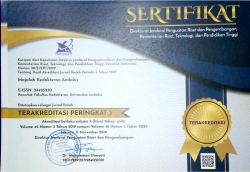Hubungan gambaran spektral pulse wave doppler dengan respon klinis terapi radiasi eksternal pada kanker serviks stadium IIB-IVA
Abstract
Tujuan: Mengetahui hubungan antara gambaran spektral Doppler USG transrektal Pulse Wave Doppler dengan respon klinis terapi radiasi eksternal pada kanker serviks stadium lokal lanjut (IIB-IVA). Metode: Menggunakan metode Prepost Design secara prospektif, dilakukan pemeriksaan Pulse wave Doppler menggunakan probe transrektal pada pasien kanker serviks stadium IIB-IVA. Pada pasien dilakukan pengukuran ukuran tumor secara ultrasonografi dan klinis sebagai ukuran awal tumor untuk menilai respon radiasi. Jumlah sampel adalah 60 untuk kelompok dengan hasil spektral Doppler baik dan buruk, yang dilakukan terapi radiasi eksternal dan dilakukan pengukuran masa kembali secara USG dan klinis untuk menentukan kriteria respon terapi. Hasil: Kelompok respon klinis buruk sebanyak 9 (75,0%) memiliki spektral vaskularisasi buruk dan sebanyak 3 (25,0%) memiliki spektral vaskularusasi baik sedangkan untuk respon klinis baik sebanyak 19(41,3%) memiliki spektral vaskularisasi buruk dan sebanyak 27 (58,7%) memiliki spektral vaskularisasi baik. Pada analisis dengan uji exact Fisher ditemukan hubungan yang bermakna (p<0,05) antara gambaran spectral PW Doppler transrektal dengan respon klinis terapi radiasi eksternal pada kanker serviks stadium IIB-IVA dengan nilai Relative Risk (RR) 3.214 kali. Kesimpulan: Terdapat hubungan yang bermakna antara gambaran spektral Doppler dengan respon klinis terapi radiasi eksternal pada kanker serviks stadium IIB-IVA.
Keywords
Full Text:
PDFReferences
World Health Organization. Preparing for the introduction of HPV vaccines: policy and programme guidance for countries. 2006.
Information Centre on HPV and Cancer. Human Papillomavirus and Related Diseases Report: World. 2016.
Departemen Kesehatan RI. Profil Kesehatan Indonesia 2008. In: Departemen Kesehatan RI, editor. Jakarta. 2009.
World Health Organization. WHO Handbook for reporting results of cancer treatment. Geneva. 1979.
Hacker NF, Vermoken JB. Cervical Cancer. In: Berek JS, editor. Berek & Hacker’s Gynecologic Oncology. 6 ed. Philadephia: Wolters Kluwer Health/Lippincott Williams & Wilkins; 2015. p.1149-390.
Information Centre on HPV and Cancer. Human Papillomavirus and Related Diseases Report: Indonesia. 2016.
Candelaria M, Arias AG, Cetina L, Gonzalez D. Radiosensitizers in cervical cancer. Cisplatin and beyond: Biomed Central; 2006. P.1-17.
Sarah K. The relevance of molecular biomarkers in cervical cancer patients treated with radiotherapy: Ann Transl Med; 2015.
Seiwert TY, Salama JK, Vokes EE. The concurrent chemoradiation paradigm-general principles: Nat Clin Pract Oncol; 2007.
Perez CA, Grigsby PW, Chao KS. Tumor size, irradiation dose, and long-term outcome of carcinoma of uterine cervix. Int J Radiat Oncol Biol Phys. 1998; 307-17.
American Cancer Society. Cervical cancer detailed guidelines. 2007.
Alcazar JL, Jurado M, Lopez-Garcıa G. Tumor vascularization in cervical cancer by 3-dimensional Pulse Wave Doppler angiography: correlation with tumor characteristics. Int J Gynecol Cancer. 2010; 393-7.
Huang YF, Cheng YM, Wu YP. Three-dimensional Pulse Wave Doppler ultrasound in cervical carcinoma: monitoring treatment response to radiotherapy. Ultrasound Obstet Gynecol. 2013; 84-92.
Pirhonen JP, Grenman SA, Bredbacka AB. Effects of external radiotherapy on uterine blood flow in patients with advanced cervical carcinoma assessed by color Doppler ultrasonography. Cancer. 1995; 67-71.
Chen CA, Cheng WF, Lee CN. Pulse Wave Doppler vascularity index for predicting the response of neoadjuvant chemotherapy in cervical carcinoma. Acta Obstet Gynecol Scand. 2004; 591-7.
Fleischer AC, Nierman KJ, Donnelly EF, Yankeelov TE, Canniff KM, Hallahan DE, et al. Sonographic depiction of microvessel perfusion. J Ultrasound Med. 2004; 1499-506.
Cosgrove D. Angiogenesis imaging-ultrasound. Br J Radiol. 2003; 43-9.
Kerimog lU, Akata D, Hazirolan T. Evaluation of radiotherapy response of cervical carcinoma with gray scale and color Doppler ultrasonography: resistive index correlation with magnetic resonance findings. Diagn Interv Radiol. 2006; 155-60.
Foster FS, Burns PN, Simpson DH, Wilson SR, Christopher DA, Goertz DE. Ultrasound of the visualization and quantification of tumor microcirculation. Cancer Metastasis. 2000; 131-8.
Epstein E. Sonographic characteristics of squamous cell cancer and adenocarcinoma of uterine cervix. Ultrasound Obstet Gynecol. 2010; 512-6.
Andrijono. Biologi Sel. Sinopsis Kanker Ginekologi 3 ed. Jakarta: Pustaka Spirit; 2009. p.19-40.
Aziz MF. Karsinogenesis. In: Aziz M, Andrijono, Saifuddin A, editors. Buku Acuan Nasional Onkologi Ginekologi. Jakarta: Yayasan Bina Pustaka Sarwono Prawirohardjo; 2006. p. 20-32.
Matthias H, Georg TV. Teaching Manual of Color Duplex Sonography: A Workbook on Color Duplex Ultrasound and Echocardiography 3 ed. Stuttgart: Thieme; 2010.
Asim K, Frank AC. Donald School Textbook of Ultrasound in Obstetrics and Gynecology. India: Jaypee Brothers Medical Publishers; 2003.
Alcazar JL, Castillo G, Martınez-Monge R. Transvaginal color Doppler sonography for predicting response to concurrent chemoradiotherapy for locally advanced cervical carcinoma. J Clin Ultrasound. 2004; 267-72.
Alcazar JL, Jurado M. Transvaginal color Doppler for predicting pathological response to preoperative chemoradiation in locally advanced cervical carcinoma: a preliminary study. Ultrasound Med Biol. 1999; 1041-5.
Belitsos P, Papoutsis D, Rodolakis A. Three-dimensional Pulse Wave Doppler ultrasound for the study of cervical cancer and precancerous lesions. Ultrasound Obstet Gynecol. 2012; 576-81.





















